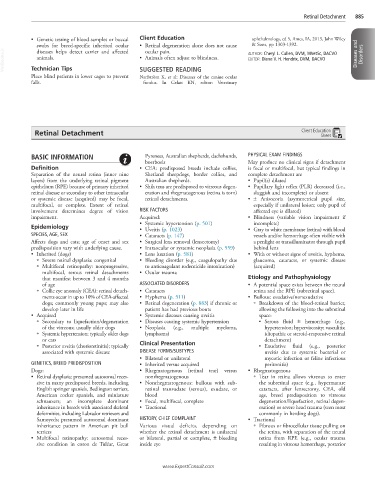Page 1760 - Cote clinical veterinary advisor dogs and cats 4th
P. 1760
Retinal Detachment 885
• Genetic testing of blood samples or buccal Client Education ophthalmology, ed 5, Ames, IA, 2013, John Wiley
swabs for breed-specific inherited ocular • Retinal degeneration alone does not cause & Sons, pp 1303-1392.
VetBooks.ir Technician Tips • Animals often adjust to blindness. AUTHOR: Cheryl L. Cullen, DVM, MVetSc, DACVO Diseases and Disorders
diseases helps detect carrier and affected
ocular pain.
animals.
EDITOR: Diane V. H. Hendrix, DVM, DACVO
Place blind patients in lower cages to prevent SUGGESTED READING
Narfström K, et al: Diseases of the canine ocular
falls. fundus. In Gelatt KN, editor: Veterinary
Retinal Detachment Client Education
Sheet
BASIC INFORMATION Pyrenees, Australian shepherds, dachshunds, PHYSICAL EXAM FINDINGS
boerboels May produce no clinical signs if detachment
Definition • CEA: predisposed breeds include collies, is focal or multifocal, but typical findings in
Separation of the neural retina (inner nine Shetland sheepdogs, border collies, and complete detachment are
layers) from the underlying retinal pigment Australian shepherds. • Pupil(s) dilated
epithelium (RPE) because of primary inherited • Shih tzus are predisposed to vitreous degen- • Pupillary light reflex (PLR) decreased (i.e.,
retinal disease or secondary to other intraocular eration and rhegmatogenous (retina is torn) sluggish and incomplete) or absent
or systemic disease (acquired) may be focal, retinal detachments. • ± Anisocoria (asymmetrical pupil size,
multifocal, or complete. Extent of retinal especially if unilateral lesion; only pupil of
involvement determines degree of vision RISK FACTORS affected eye is dilated)
impairment. Acquired: • Blindness (variable vision impairment if
• Systemic hypertension (p. 501) incomplete)
Epidemiology • Uveitis (p. 1023) • Gray to white membrane (retina) with blood
SPECIES, AGE, SEX • Cataracts (p. 147) vessels and/or hemorrhage often visible with
Affects dogs and cats; age of onset and sex • Surgical lens removal (lensectomy) a penlight or transilluminator through pupil
predisposition vary with underlying cause. • Intraocular or systemic neoplasia (p. 559) behind lens
• Inherited (dogs) • Lens luxation (p. 581) • With or without signs of uveitis, hyphema,
○ Severe retinal dysplasia: congenital • Bleeding disorder (e.g., coagulopathy due glaucoma, cataracts, or systemic disease
○ Multifocal retinopathy: nonprogressive, to anticoagulant rodenticide intoxication) (acquired)
multifocal, serous retinal detachments • Ocular trauma
that manifest between 3 and 4 months Etiology and Pathophysiology
of age ASSOCIATED DISORDERS • A potential space exists between the neural
○ Collie eye anomaly (CEA): retinal detach- • Cataracts retina and the RPE (subretinal space).
ments occur in up to 10% of CEA-affected • Hyphema (p. 511) • Bullous: exudative/nonexudative
dogs; commonly young pups; may also • Retinal degeneration (p. 883) if chronic or ○ Breakdown of the blood-retinal barrier,
develop later in life patient has had previous bouts allowing the following into the subretinal
• Acquired • Systemic diseases causing uveitis space:
○ Secondary to liquefaction/degeneration • Diseases causing systemic hypertension ■ Serous fluid ± hemorrhage (e.g.,
of the vitreous; usually older dogs • Neoplasia (e.g., multiple myeloma, hypertension; hyperviscosity; vasculitis;
○ Systemic hypertension; typically older dogs lymphoma) idiopathic or steroid-responsive retinal
or cats detachment)
○ Posterior uveitis (chorioretinitis); typically Clinical Presentation ■ Exudative fluid (e.g., posterior
associated with systemic disease DISEASE FORMS/SUBTYPES uveitis due to systemic bacterial or
• Bilateral or unilateral mycotic infection or feline infectious
GENETICS, BREED PREDISPOSITION • Inherited versus acquired peritonitis)
Dogs: • Rhegmatogenous (retinal tear) versus • Rhegmatogenous
• Retinal dysplasia: presumed autosomal reces- nonrhegmatogenous ○ Tear in retina allows vitreous to enter
sive in many predisposed breeds, including • Nonrhegmatogenous: bullous with sub- the subretinal space (e.g., hypermature
English springer spaniels, Bedlington terriers, retinal transudate (serous), exudate, or cataracts, after lensectomy, CEA, old
American cocker spaniels, and miniature blood age, breed predisposition to vitreous
schnauzers; an incomplete dominant • Focal, multifocal, complete degeneration/liquefaction, retinal degen-
inheritance in breeds with associated skeletal • Tractional eration) or severe head trauma (seen most
deformities, including Labrador retrievers and commonly in herding dogs).
Samoyeds; presumed autosomal dominant HISTORY, CHIEF COMPLAINT • Tractional
inheritance pattern in American pit bull Various visual deficits, depending on ○ Fibrous or fibrocellular tissue pulling on
terriers whether the retinal detachment is unilateral the retina, with separation of the neural
• Multifocal retinopathy: autosomal reces- or bilateral, partial or complete, ± bleeding retina from RPE (e.g., ocular trauma
sive condition in coton de Tuléar, Great inside eye resulting in vitreous hemorrhage, posterior
www.ExpertConsult.com

